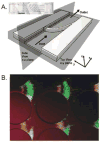Rare Cell Capture in Microfluidic Devices
- PMID: 21532971
- PMCID: PMC3082151
- DOI: 10.1016/j.ces.2010.09.012
Rare Cell Capture in Microfluidic Devices
Abstract
This article reviews existing methods for the isolation, fractionation, or capture of rare cells in microfluidic devices. Rare cell capture devices face the challenge of maintaining the efficiency standard of traditional bulk separation methods such as flow cytometers and immunomagnetic separators while requiring very high purity of the target cell population, which is typically already at very low starting concentrations. Two major classifications of rare cell capture approaches are covered: (1) non-electrokinetic methods (e.g., immobilization via antibody or aptamer chemistry, size-based sorting, and sheath flow and streamline sorting) are discussed for applications using blood cells, cancer cells, and other mammalian cells, and (2) electrokinetic (primarily dielectrophoretic) methods using both electrode-based and insulative geometries are presented with a view towards pathogen detection, blood fractionation, and cancer cell isolation. The included methods were evaluated based on performance criteria including cell type modeled and used, number of steps/stages, cell viability, and enrichment, efficiency, and/or purity. Major areas for improvement are increasing viability and capture efficiency/purity of directly processed biological samples, as a majority of current studies only process spiked cell lines or pre-diluted/lysed samples. Despite these current challenges, multiple advances have been made in the development of devices for rare cell capture and the subsequent elucidation of new biological phenomena; this article serves to highlight this progress as well as the electrokinetic and non-electrokinetic methods that can potentially be combined to improve performance in future studies.
Figures



References
-
- Adams AA, Okagbare PI, Feng J, Hupert ML, Patterson D, Gottert J, McCarley RL, Nikitopoulos D, Murphy MC, Soper SA. Highly efficient circulating tumor cell isolation from whole blood and label-free enumeration using polymer-based microfluidics with an integrated conductivity sensor. Journal of the American Chemical Society. 2008;130:10. [2, 4, 5, 19] - PMC - PubMed
-
- Bao N, Wang J, Lu C. Recent advances in electric analysis of cells in microfluidic systems. Analytical and bioanalytical chemistry. 2008;391:933–42. [9] - PubMed
-
- Barrett LM, Skulan AJ, Singh AK, Cummings EB, Fiechtner GJ. Dielectrophoretic manipulation of particles and cells using insulating ridges in faceted prism microchannels. Analytical chemistry. 2005;77:6798–804. [15] - PubMed
-
- Braschler T, Demierre N, Nascimento E, Silva T, Oliva AG, Renaud P. Continuous separation of cells by balanced dielectrophoretic forces at multiple frequencies. Lab on a chip. 2008;8:280–6. [12] - PubMed
Grants and funding
LinkOut - more resources
Full Text Sources
Other Literature Sources
